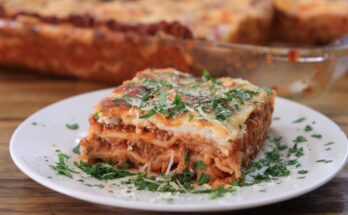Thanksgiving Dressing Recipe: Thanksgiving isn’t quite complete without a warm, aromatic dish of dressing on the table. While turkey might be the centerpiece, the dressing is the dish everyone comes back for seconds.
It’s rich, savory, and packed with flavor from bread, herbs, and vegetables—sometimes with a bit of sausage or mushrooms for extra oomph.
In this step-by-step guide, we’re going to break down exactly how to make a dressing that’s not just delicious, but unforgettable.
What is Dressing vs Stuffing?
First things first—let’s settle the age-old debate: is it dressing or stuffing? Technically, stuffing is what goes inside the turkey, and dressing is baked outside the bird in a separate dish. But the terms are often used interchangeably, especially depending on where you’re from. In the Southern U.S., you’ll usually hear “dressing,” even if it’s made exactly like stuffing. The truth is, it’s the same hearty, savory mix of bread, vegetables, and seasonings either way—it just depends on how you cook it.
That said, for food safety and better texture, many home cooks now prefer dressing baked on its own. You get that perfectly crispy top and soft, flavorful interior. No soggy bites or worries about undercooked poultry juices. Plus, baking it separately means you can make a bigger batch—because let’s be real, no one wants to run out of dressing.
Why Dressing is a Thanksgiving Staple
The beauty of dressing is its versatility and ability to soak up every bit of fall flavor. It’s like a cozy blanket of herbs, butter, and broth that brings the whole meal together. While the turkey might be dry if you’re not careful, the dressing never fails. You can load it up with savory bits like sausage, mushrooms, apples, or even oysters if you’re feeling traditional. It’s the ultimate comfort food, and every family has their own take on it.
Whether you’re going classic or adding your own twist, dressing holds a special place in Thanksgiving traditions. It’s nostalgic, satisfying, and always a crowd-pleaser.
Essential Ingredients for a Perfect Dressing
Creating the perfect dressing starts with understanding your ingredients. Each component plays a key role in delivering that perfect combination of crispy and soft textures, infused with savory, herbaceous flavor.
Bread – The Foundation of Flavor
Bread is the heart of any dressing. It soaks up all the delicious broth and seasonings, creating a texture that’s both hearty and soft. You want a bread that’s dense enough to hold its shape but not too crusty. Day-old bread is best because it’s slightly dried out, which helps it absorb the liquid without turning to mush.
Common choices include:
- White sandwich bread (great all-purpose base)
- Sourdough (adds a tangy kick)
- Cornbread (for Southern-style dressing)
- French bread or Italian loaves (for a rustic texture)
Whatever bread you use, cut it into ½ to 1-inch cubes and let it dry out overnight. If you’re short on time, toast the cubes in the oven until slightly crispy.
Vegetables and Aromatics
The flavor starts with the holy trinity of onions, celery, and carrots. These aromatics are sautéed in butter until soft and fragrant. Some people also add garlic, mushrooms, leeks, or bell peppers, depending on the family recipe.
- Onions: Yellow onions are a safe, flavorful choice. Shallots add a delicate sweetness.
- Celery: Adds crunch and that classic Thanksgiving taste.
- Carrots: Optional but great for color and slight sweetness.
- Mushrooms: Add umami depth—especially good if you’re skipping meat.
Be sure to dice everything evenly so they cook uniformly.
Herbs and Seasonings
This is where your dressing gets its signature Thanksgiving flavor. Classic herbs include:
- Sage: Earthy, pungent, and essential.
- Thyme: Adds complexity and depth.
- Rosemary: Use sparingly—strong but aromatic.
- Parsley: Freshens up the dish and adds brightness.
- Salt and Pepper: Don’t skimp! Bread soaks up a lot of seasoning.
You can use fresh herbs for brightness or dried ones for intensity—just remember the rule: use about 1/3 the amount of dried herbs compared to fresh.
Liquids and Binders
To bring it all together, you’ll need a mix of liquid and binder to moisten the bread and help the dish hold its shape.
- Chicken or vegetable broth: Adds rich, savory moisture.
- Butter: For sautéing veggies and flavor.
- Eggs: Act as a binder to hold the dressing together.
- Optional Add-ins: Sausage (browned beforehand), apples, nuts, cranberries, or even oysters.
The key is balance—moist but not soggy, firm but not dry. Taste as you go and adjust the liquid as needed.
Choosing the Right Bread
Not all bread is created equal when it comes to dressing. Your choice here can drastically affect the final texture and flavor.
Fresh vs Stale Bread
You might be tempted to grab a fresh loaf and dive in, but stale bread is actually your best friend. Fresh bread is too soft and can turn your dressing into a gummy mess. Stale or toasted bread holds up better and absorbs broth without breaking down too fast.
Here’s a tip: if you forgot to dry your bread overnight, just spread the cubes on a baking sheet and toast them at 300°F for 15–20 minutes. Flip halfway to ensure even drying.
Best Bread Types for Dressing
So what’s the best bread for Thanksgiving dressing? It depends on your flavor profile:
- White sandwich bread: A neutral base that lets herbs and broth shine.
- Cornbread: For a Southern twist—crumbly, slightly sweet.
- Brioche or challah: Rich and buttery but be careful—they soak up a lot.
- Sourdough: Adds a tang that pairs well with savory elements like sausage.
Feel free to mix and match! A combo of white bread and cornbread, for example, adds both structure and flavor.
Preparing the Base: Sautéing the Vegetables
This is where your dressing starts to smell like Thanksgiving. Sautéing the vegetables in butter builds a flavor base that carries through every bite.
Onion, Celery, and Carrot Basics
Start with a large skillet and melt plenty of butter (at least 1 stick). Add chopped onions, celery, and carrots. Cook over medium heat, stirring often, until the veggies are soft and fragrant—about 10–12 minutes.
Don’t rush this step. You want the onions to be translucent and just starting to caramelize, which brings out their sweetness. This is the soul of your dressing, so give it time.
Using Butter for Richness
Butter does more than cook your vegetables—it adds depth, fat, and a golden richness that ties the dish together. Some people use a mix of butter and olive oil, especially if adding sausage. Either way, don’t skimp. Dressing isn’t the time to go low-fat!
Step-by-Step Instructions to Make Thanksgiving Dressing
Let’s bring it all together now with the actual process. These next steps will show you exactly how to prepare your Thanksgiving dressing from start to finish.
Step 1: Toast the Bread Cubes
Start with about 12 cups of dried bread cubes. Toast them in the oven if needed, and place them in a large mixing bowl.
Step 2: Sauté the Aromatics
In a large skillet, melt 1 stick of butter. Add 1 diced onion, 2–3 celery stalks, and optional carrots or garlic. Sauté until tender. Add your herbs—sage, thyme, and parsley—during the last minute of cooking.
Step 3: Combine Ingredients
Pour the sautéed veggies over the bread cubes. Mix well. Add salt, pepper, and any extras like cooked sausage or mushrooms.
Step 4: Add Broth and Eggs
Slowly pour in 2–3 cups of warm broth and toss gently until the bread is moist but not soggy. Add 2 beaten eggs to help bind everything together.
Step 5: Bake to Golden Perfection
Transfer the mixture to a greased baking dish. Cover with foil and bake at 350°F for 30 minutes. Remove the foil and bake another 15–20 minutes until golden and crispy on top.
How to Customize Your Dressing
Everyone’s Thanksgiving table looks a little different—and your dressing can, too! Once you’ve got the basics down, it’s easy to tweak the recipe to suit your taste buds or dietary needs.
Adding Protein: Sausage, Bacon, or Turkey
Adding meat is one of the best ways to amp up the savory factor in your dressing. It turns a side dish into something so hearty, you could eat it as a meal by itself.
- Sausage: Brown a half pound to a full pound of pork sausage before adding it to your mix. Sage-flavored sausage blends especially well with the herbs in your dressing.
- Bacon: Cook until crispy, crumble, and fold it into the mix for a smoky kick.
- Turkey or Chicken: Shredded or chopped cooked poultry can make your dressing even more filling.
Make sure all meats are fully cooked before mixing them in—you’re just reheating everything during the bake.
Vegetarian and Vegan Options
If you’re serving guests who don’t eat meat, it’s easy to adapt this dish.
- Use vegetable broth instead of chicken stock.
- Swap out butter with vegan butter or olive oil.
- Leave out eggs or use a flax egg substitute (1 tablespoon ground flaxseed + 3 tablespoons water = 1 egg).
- Load up on flavorful veggies like mushrooms, sun-dried tomatoes, or roasted bell peppers.
A vegan version of dressing can be just as satisfying with a bit of creativity and the right seasonings.
Common Mistakes to Avoid
Dressing might seem simple, but it’s easy to make a few mistakes that take it from perfect to just okay. Let’s look at the pitfalls and how to avoid them.
Over-Soaking the Bread
Too much liquid and your dressing turns soggy. Too little, and it’s dry and crumbly. The key is to add broth slowly. Your bread should be moist but still hold its shape. Let the mixture sit for a few minutes after mixing to see how the bread absorbs the liquid before adding more.
Under-Seasoning
Bread is bland—it soaks up flavors but also dulls them if you’re not generous. Taste your broth before you mix it in. If it’s not full of flavor, your dressing won’t be either. Don’t be afraid of salt and herbs.
Also, be mindful of using low-sodium broth—if you do, add a bit of extra salt to compensate.
Uneven Texture
Mixing everything in one go can lead to dry pockets and soggy bits. Make sure your sautéed veggies are spread evenly throughout the bread, and stir thoroughly. If you’re using mix-ins like sausage or nuts, distribute them well.
Not Baking Long Enough
The middle of your dressing needs time to set and bind. Always bake covered first to steam the center, then uncover to crisp up the top. Underbaking can lead to a mushy center.
Make-Ahead and Storage Tips
Want to free up your Thanksgiving Day schedule? Dressing is one of the best dishes to make ahead.
Preparing Ahead of Time
You can prepare the dressing up to two days in advance.
- Day before: Toast the bread, chop the veggies, and cook your sausage or other add-ins.
- Assemble the day before or morning of: Mix everything together and store the unbaked dressing in the fridge, tightly covered.
Pull it out 30 minutes before baking so it can come to room temperature. This helps it cook evenly.
Storing Leftovers
Cooked dressing keeps well in the fridge for up to 4 days.
- Store in an airtight container.
- Reheat in the oven (covered) at 325°F for 20 minutes to maintain texture.
- You can also microwave individual servings, but they’ll lose that crispy top.
Freezing Dressing
Yes, dressing freezes beautifully!
- Freeze unbaked dressing tightly wrapped in foil.
- When ready to use, thaw in the fridge overnight and bake as directed.
- Already baked? Freeze leftovers in portions and reheat as needed.
Pairing Dressing with Other Thanksgiving Dishes
Dressing is a team player—it pairs with almost everything on the table, but some dishes really bring out its flavor.
Best Mains
- Roast Turkey: Of course. The classic pairing.
- Herb-Rubbed Chicken: For smaller gatherings.
- Roast Pork or Ham: A saltier meat cuts through the richness of the dressing.
- Stuffed Squash (Vegetarian Option): For a cozy, meatless pairing.
Delicious Sides to Serve Alongside
- Cranberry Sauce: Adds a sweet-tart contrast.
- Mashed Potatoes and Gravy: You can drizzle some gravy over your dressing too—highly recommended.
- Green Bean Casserole: A veggie-forward side that complements the herbs.
- Roasted Brussels Sprouts or Carrots: Adds color and earthy depth.
Create a plate that balances the rich, savory flavor of the dressing with something acidic, something sweet, and something crunchy.
FAQs about Thanksgiving Dressing Recipe
1. What’s the difference between stuffing and dressing?
Stuffing is traditionally cooked inside the turkey, while dressing is baked separately in a casserole dish. Both use similar ingredients but differ in preparation.
2. Can I make Thanksgiving dressing ahead of time?
Yes! You can prep it a day in advance. Just cover and refrigerate, then bake when ready to serve.
3. What kind of bread is best for dressing?
Day-old cornbread or white bread works best. It holds its shape and absorbs flavor better than fresh bread.
4. How moist should the dressing be before baking?
The mixture should be moist but not soggy. If it feels dry, add a bit more broth before baking.
5. Can I freeze leftover dressing?
Absolutely. Let it cool completely, then store in an airtight container in the freezer for up to 3 months.
Conclusion
Thanksgiving dressing isn’t just another side—it’s a must-have that brings comfort, warmth, and a whole lot of flavor to the holiday table. Whether you’re sticking with the traditional version or giving it a unique spin with meats or plant-based swaps, dressing is incredibly adaptable and forgiving. The key is getting the right balance of moist and crispy, herbaceous and hearty.
So now that you’ve got the step-by-step breakdown, go ahead—make it your own. Toast the bread, sauté those veggies, and don’t be afraid to mix things up. Because at the end of the day, dressing is all about family, tradition, and that unbeatable, soul-soothing taste of home.



